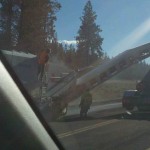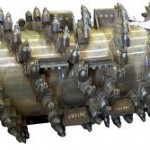Fri 5 Nov 2010
Asphalt milling machines – a big silica problem
Posted by admin under Engineering Controls, Noise, Respirators, Silica
[3] Comments
Asphalt milling machines are used to remove road asphalt in wide sections. It has been awhile since I’ve had the opportunity to perform air monitoring for silica on these operations.  However, my experience in the past tells me that they can produce a lot of respirable silica dust. I snapped this picture while I was driving (I was going slow, but yea- probably not safe) on a road crew working. I didn’t capture the cloud of dust hitting the sunlight, but it was a beautiful/scary sight.
However, my experience in the past tells me that they can produce a lot of respirable silica dust. I snapped this picture while I was driving (I was going slow, but yea- probably not safe) on a road crew working. I didn’t capture the cloud of dust hitting the sunlight, but it was a beautiful/scary sight.
The drums on the asphalt machines have many sharp teeth. The drum is lowered onto the asphalt surface and basically chews up the asphalt while carrying it to a belt.  As you can imagine, the drum gets really hot. Water is kept on board the milling machine to cool the drum. The theory is that the drum is wet, so the silica issue must be at a minimum. I have found really high exposures to airborne respirable silica during this process. I believe due to the water NOT being directed at the cutting teeth.
As you can imagine, the drum gets really hot. Water is kept on board the milling machine to cool the drum. The theory is that the drum is wet, so the silica issue must be at a minimum. I have found really high exposures to airborne respirable silica during this process. I believe due to the water NOT being directed at the cutting teeth.
The solution? Unfortunately, I don’t have an easy one. For starters, I’d make sure the water is directed at the point of cutting (which can vary from day to day). Respirator are not really an option. The road crew must communicate with each other and doing this with a respirator is extremely hard. The noise from these operations is also very high and most crews have ear muffs with communication head-sets.
I would love to hear your comments on engineering solutions to this issue. I don’t believe there is much research going into this issue.
3 Responses to “ Asphalt milling machines – a big silica problem ”
Trackbacks & Pingbacks:
-
[…] silica problem. Water controls are enough. You need a local exhaust system too. (here’s an earlier post I made on […]
http://enr.construction.com/people/awards/2011/0112-Gary_Fore.asp summarizes control research. An ongoing NIOSH research partnership.
Thank you for the info Alan.